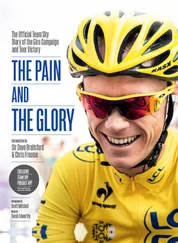He loves it if you respond: ‘Bos in Manchester.’ It allows him to counter with: ‘Nah, mate – Bourgain in Copenhagen.’
He’s right. I was riding in Copenhagen purely to try and qualify an extra British sprinter for the Olympics. My own ticket to Beijing rested on the keirin; I had to beat my old rival Arnaud Tournant, another Frenchman, to win the series, and thus qualify for Beijing.
The meeting had started on the Friday evening with the team sprint, and we had a terrible night, giving one of our worst performances in this event in recent years. While the French dominated, again, we could only qualify fourth, and then lost out to the Netherlands – led by Bos – in the ride for the bronze medal.
The next day was better: I reached the final of the keirin, which proved a bit of an epic. Tournant was just as keen to win, since that would guarantee him his Olympic place, and he and his team-mate, Grégory Baugé, both laid it on thick in the final, launching a series of attacks but ultimately failing to overake me, as I led from the front to win the race and the series, and secure my ticket to Beijing.
Competing in the sprint, on the third day, felt a bit like doing my duty for the team. Thanks to the keirin I was now guaranteed my Olympic place, which I was delighted about. But I didn’t know if I’d ride all three events in Beijing. To be honest, I didn’t know if I had it in me, and worried that I could spread myself a little too thinly by attempting such a full programme.
Added to this general uncertainty was the fact that there was a fourth event to do in Copenhagen: the lucrative Japanese invitational keirin, with its £10,000 first prize. I was doing that, too – well, that prize was quite an incentive – and I knew that by Sunday evening my legs would be in bits.
But first up in the morning was the 200-metre time trial that acts as the qualifier for the sprint, and determines the subsequent draw. I was third with 10.2 seconds, behind yet another of those fast Frenchmen, Kévin Sireau, with Bourgain second. I progressed fairly smoothly through a few rounds before my meeting with Bourgain in the semi-final.
In the first race I didn’t ride well. It was the same problem that I often encountered in these head-to-head races. Though I had the raw speed, my tactics were a bit dodgy. OK, I’m being kind to myself. Basically, I only had one strategy. All the decent rides I’d done so far had seen me going from the front, setting a fast pace, trying to take the sting out of my opponent’s tail, and then countering them when they made their move. It was a very one-dimensional way to ride, and it only worked if I could get to the front in the first place. And – not surprisingly, given that my opponents would have studied me in competition, just as I studied them – they were getting wise to it. So Bourgain beat me. One-nil.
I came off the track feeling pretty tired, and pretty discouraged. To add to my general dejection, I was then sick as I sat on the stationary rollers, keeping my legs spinning – and the lactic acid at bay – between races.
I could feel that something wasn’t right, and called Jan over, asking him to discreetly fetch a bucket, or some other water- (or vomit-) tight container. ‘But make sure no one can see what you’re doing,’ I told him; I didn’t want any of my opponents to see that I was suffering so badly. Jan carried out the task to perfection, providing and then dispensing with the container before anyone saw anything. I should point out that vomiting is not uncommon; the repeated sprint efforts create such high lactic acid concentrations that they can, literally, make you sick.
My little bout of sickness didn’t distract Jan from the mission that remained ahead of me: to beat Bourgain. ‘He knows you can do that,’ he said, referring to my one and only tactic. ‘You gotta go from the back!’
I had tried going from the back in previous sprint matches, but I found it difficult to commit. What would happen is that my opponent would stall, I would hold back a little, and then we’d both end up ‘jumping’ – that is, opening our sprint – at the same time. The whole point of coming from behind is that you should have the element of surprise. But to gain the advantage you have to jump first, preferably without your opponent seeing you. If you both jump at the same time, and are going at more or less the same speed, it’s extremely hard to come around the other rider, since he has the inside line, and therefore less distance to travel.
‘Look,’ said Jan. ‘You’re one-nil down, so you’ve got nothing to lose. I don’t care about the outcome. I just want to see you try to execute this race tactically.’
Why did I lack the confidence to go from the back? The problem, I think, was that I had bought into the misconception that the guy at the front controls the race. It’s very difficult to hold back, to be patient and sit a couple of lengths behind someone, maintaining your place high on the banking and waiting for the right time to make your move. But what Jan kept drilling into me was the idea that the guy at the back can be the one dictating the tactics; and, as he told me now, my second-round match against Bourgain offered the ideal opportunity to test this theory. As he kept saying, I had nothing to lose.
I knew it was true, but it’s a difficult mindset to take into a race. I was determined, however, to follow Jan’s instructions, to force Bourgain to the front and then attack him. From behind I was able to force him to commit early, while I waited and waited and – going against my instincts – waited some more. Coming into the bell lap I was quite a bit down, but he was going full gas, while I was still winding it up. Even coming off the back straight I was still about a length behind, but I was gaining, and I remember thinking, I’m going to pass him here. And I did, eating up the gap on the home straight, crossing the line first and thinking: that was easy. Although it only levelled the contest at 1–1, I knew that was the turning point. Suddenly, I had the momentum – the upper hand.
There was only a 10-minute break between the second and third rides – hardly even enough time to vomit – and I was feeling completely exhausted by now; as if I didn’t have another effort in my legs. But I suspected that Bourgain – though he hadn’t had as busy a weekend as me, missing the previous day’s keirin – would be feeling pretty tired as well. It’s at this stage of the competition that the mind games come in. You’re in the track centre, warming up in full view of your opponents, and the trick is to appear less tired than you actually feel (and, if you’re going to throw up, to do so secretly).
I rode slowly around the track centre, preparing for that third ride, with Bourgain himself following the same routine just yards away, and then I made sure I went up to the start first. I wasn’t going to be seen delaying it, buying some more recovery time. When we were called, I was straight there, and I made sure I didn’t slouch in the chair as we waited to go to the line.
When Bourgain came and sat beside me he was shaking his legs out, and stretching them, clearly trying to revive them. Beside him, I sat perfectly still and bolt upright, trying to send out the message that I was fresh, that I was up for it. A pre-race ritual is the presentation of the ‘pegs’ that determine the starting order: peg one means you are on the inside, and lead the sprint off, with peg two giving you the rear position. I picked peg one and sprang up, heading straight to the start. My legs were screaming, but it was all about bluffing it at this point. I’ve no idea whether any of this psychological warfare had any effect.
Following Jan’s advice again, I used the same tactic in the third ride. Once I had forced Bourgain to the front he tried to get me to go past him again, slowing right down, almost coming to a standstill. I could have gone early – and in previous races probably would have panicked and done exactly that – but I stuck to the tactic of sitting patiently behind him, keeping high up the banking, forcing Bourgain to make the first move. Then, again as in the second ride, I swept past him to win, and make the final.
Читать дальше












